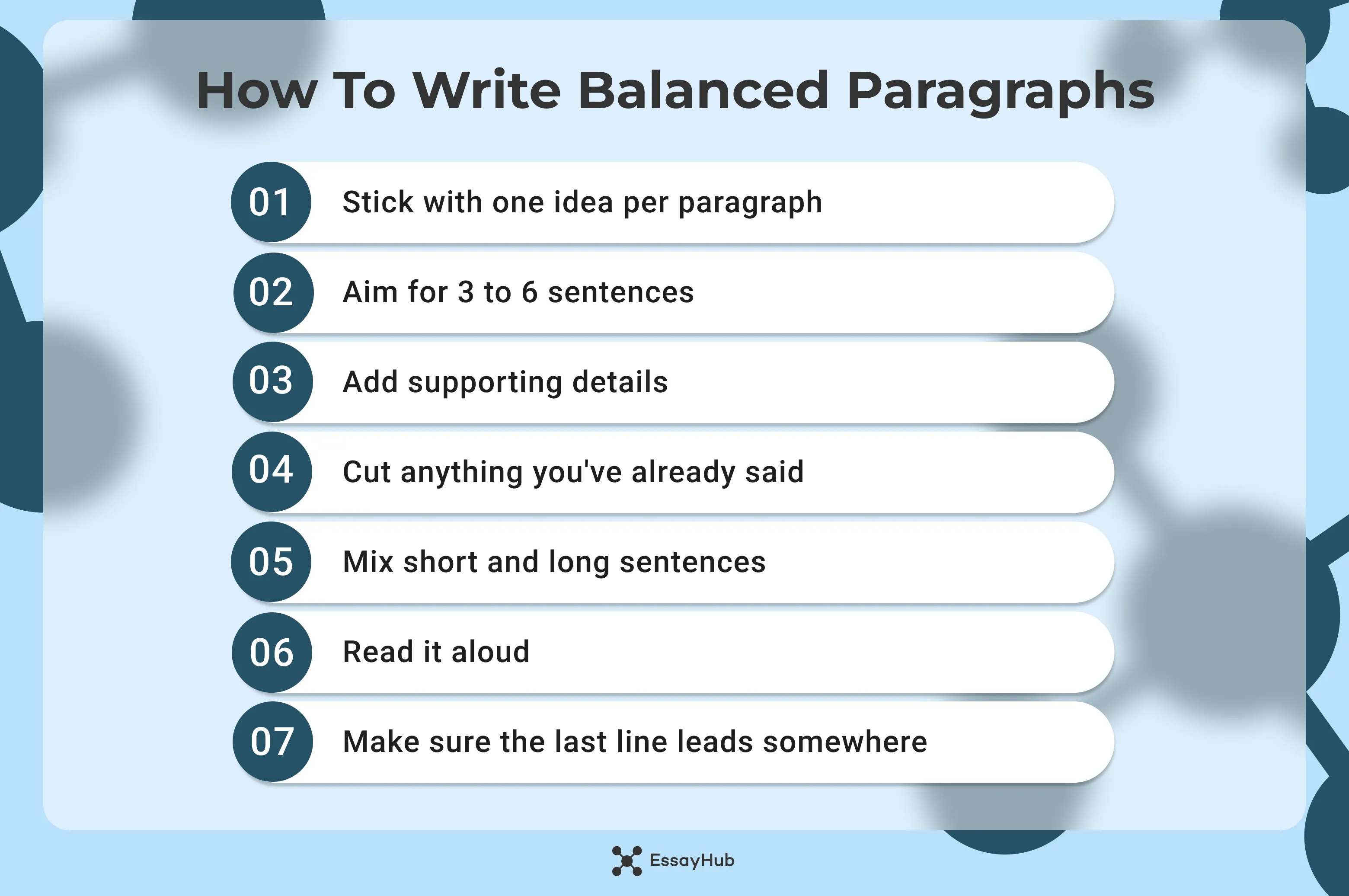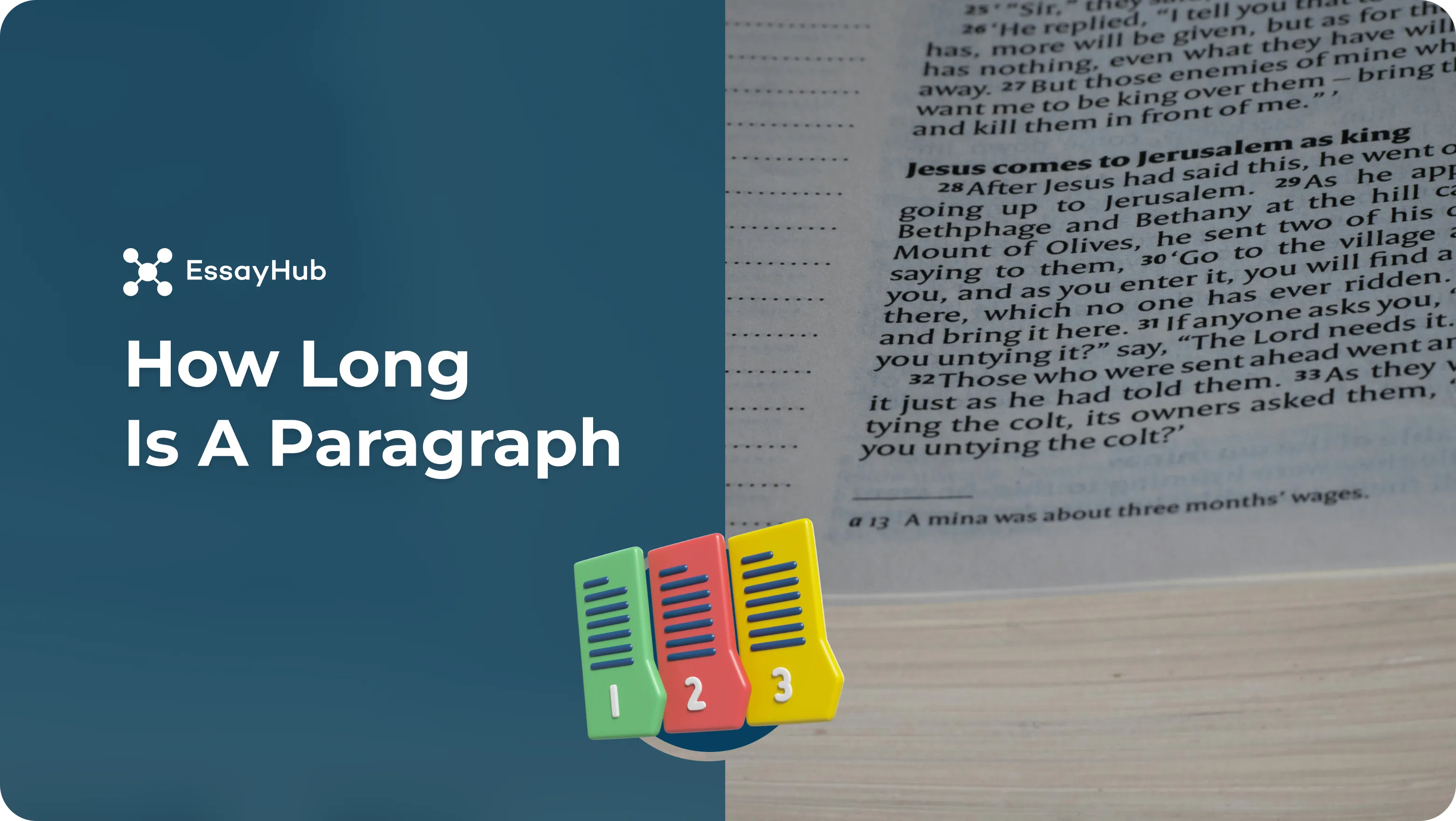As you begin to write your papers, a familiar question probably comes to mind: how long is a paragraph supposed to be? If you need a concrete number, most fall between 100 and 200 words, or usually around 3 to 6 sentences. But a solid paragraph isn’t measured by length alone. It holds its shape by its ability to stay centered on one idea from the first word to the last.
In this article, we'll talk about the length of paragraphs and why getting the numbers right makes everything smoother. And if you still can't figure out how long should a paragraph be, EssayHub can step in and help. Whenever you ask, ‘write my essay for me,’ our professionals can help you get every detail of your papers just right.
What Is a Paragraph?
A paragraph is the smallest unit of thought in your writing. It usually begins with a topic sentence. Then come the supporting sentences that give context or explanation. It's also where you list examples and evidence. The last line either ties the thought together or gently nudges the reader into the next one.
A good paragraph doesn't try to do too much with unrelated points. If the focus starts to drift or you catch yourself jumping tracks mid-way through, that's a sign it needs to be split in two. One idea, one paragraph. That's the deal.
How Many Sentences Are in a Paragraph?
Well-written paragraphs say everything in just 3 to 6 sentences. Although no magic number exists regarding paragraph lengths, this is the perfect interval to say something without turning it into a wall of text. Paragraphs between 100-200 words can be just as powerful as long as they're complete.
Typically, the sentences in a paragraph go like this: the initial one presents the point. The following few add the details: examples, explanation, etc. The last sentence either concludes or points toward what's coming next. You're creating a rhythm. If the paragraph can be read as one long breath, you're doing well.
Here's an example of a solid paragraph:
'I didn't expect the forest to go that quiet. One moment, there were birds, wind, the usual rustling, and then nothing. Even the leaves stopped moving. I held still, unsure if something was watching or if I was spooking myself again. That kind of silence plays tricks on your brain. After a few more steps, everything returned at once: something cracked in the brush, and I could hear my breathing again.'
See also: How to write a conclusion.
When a Paragraph Is Too Short
Some paragraphs end before they begin. You introduce an idea without an explanation or anything that helps the reader understand what you mean. A paragraph isn't finished if it leaves your point hanging mid-air. To build it out, you should slow down and look at what's missing. Can you explain why your point matters in more detail? Try pulling in an example or a quick piece of evidence, even a sentence that somehow connects to what came before. Don't just throw words to increase the length of a paragraph just for the sake of it, though; you need to give your idea enough support with your writing.
When a Paragraph Is Too Long
Sometimes you look back at what you've written and realize the paragraph just... kept going. Halfway through, it might have lost focus or dragged on with irrelevant side points. That's the moment when your paragraph needs shortening. But it takes more than just deleting some words.
First, figure out the core idea of the paragraph. Then, identify where it ends. Give each point in a paragraph its own space. Then, go through the entire thing sentence by sentence: nothing that doesn't move the point forward needs to stay. A longer paragraph works only when it feels smooth. Otherwise, it will just seem like you couldn't find the brakes.
How to Write Balanced and Engaging Paragraphs?
We've already said that balanced paragraphs aren't determined by how many sentences are packed inside. The main thing is that they must read like a complete thought. To get there, you could try these tips:

- Stick with one idea and see it through. Don’t wander off mid-paragraph.
- Aim for 3 to 6 sentences in a paragraph. Too short will feel abrupt. Make it too long, and the reader will forget where they’re headed.
- Add detail that shows rather than tells. If you say someone’s nervous, no one flinches. But if their hands won’t stop picking at the sleeve of a sweater, that’s already something.
- Cut anything you've already said. If you already made the point, don’t return to it.
- Mix short and long sentences. That variety and rhythm make your writing feel more alive.
- Read it aloud. It will help you catch awkward phrasing and rushed sentences.
- Make sure the last line leads somewhere. Endings don’t have to be clever, but they should land. Don’t drop it like you forgot you were mid-thought.
If you still can’t get your head around writing complete paragraphs, you can always give our AI paragraph rewriter a try.
Final Thoughts
No magic number makes a paragraph work. Some need a few tight sentences. Others need a little more room. What matters is clarity: one idea, developed with just enough detail, wrapped up before it overstays its welcome.
If you're figuring out how to shape your writing, you could pay for essay on EssayHub. Our reliable professionals can give you just the right guidance, not for essays specifically, but for most pieces of academic writing in between.
FAQ
How Many Words in a Paragraph?
Although there's no strict rule, most paragraphs land between 100 and 200 words. What matters is that the paragraph does not leave the reader hanging.
Can a Paragraph Be 3 Sentences?
Yes, a paragraph can absolutely be three sentences long. If those three sentences make a clear point, that's all you need.
How Long Is 1 Paragraph?
A paragraph usually falls between 100 and 200 words. The exact word count is less important as long as it reads like a complete thought instead of just a block of text thrown in.
- Paragraphs – The Writing Center • University of North Carolina at Chapel Hill. (2024, May 14). The Writing Center • University of North Carolina at Chapel Hill. https://writingcenter.unc.edu/tips-and-tools/paragraphs
- Bartram, J. (n.d.). LibGuides: Writing academically: Paragraph structure. Libguides.hull.ac.uk. https://libguides.hull.ac.uk/writing/paras



